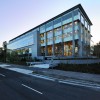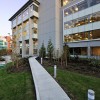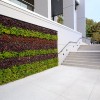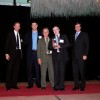When Building Green, Spend Money Where It Counts
Tenants want to lease space in green buildings. Expand your design options by finding creative ways to partner with green tenants early on.In the current market, building green is a sound business practice, and it doesn’t have to require spending money on trendy green products. It is feasible to build to LEED certification standards by focusing on a few core building systems. Furthermore, cost and risks can be defrayed if everyone on the project – even the end user – is working toward the same goal, as is exemplified by the DiscoveryGreen building located in Vancouver, B.C., which achieved LEED Platinum certification.
 Courtesy of Discovery Parks Trust
Courtesy of Discovery Parks Trust

DiscoveryGreen: Part of a Unique Business Model
The Discovery Parks Trust was established in 1979, when it was granted an endowment of 80 acres by the provincial government of British Columbia. It operates in conjunction with the not-for-profit Discovery Foundation for the benefit of post-secondary institutions in the region. On its acreage, Discovery Parks Trust has built research facilities which provide space for start-up companies that are based on technologies originating from educational research. These technologies are developed and commercialized, and the profits are reinvested in local post-secondary institutions, either to build buildings on campus or in the form of funds that go directly to vice presidents of research.
DiscoveryGreen, the last building on the original 80-acre site, was completed in 2009.
Put Effort Where it Counts
Reasons to Consider VRF
- Modular in nature, the system's units are easily transported and installed.
- Also because of their modular nature, they are flexible for design purposes.
- The system can accommodate different temperatures in different building zones, simultaneously heating one area and cooling another.
- VRF reduces the amount of ductwork in buildings, saving space and preventing thermal loss associated with duct walls.
- The cost is comparable to traditional HVAC systems.
Original plans for DiscoveryGreen were created by Bunting Coady Architects in 2000. Says Tom Douglas, Director of Development and Leasing for Discovery Parks Trust, “At that time, the market was difficult. We didn’t go ahead with the building plans; the design was put on the shelf for four or five years. Then, when market conditions improved, we redesigned the building to be sustainable.” It wasn’t necessary to go back to the drawing board, however. Bunting Coady has a long history of designing sustainably, so they had already designed a green building. Although a few additions were made to the original plans (for example, sunshades and the use of glazing which would optimize passive solar heat), the overall design was not modified. When bringing the building into compliance with LEED requirements, the team focused on improving the electrical and mechanical systems.
"We didn’t put in things which seemed to have low payback value. We used well-established technologies." Tom Douglas, Director of Development and Leasing for Discovery Parks Trust on building sustainably.
“We earned eight LEED points by using a mechanical system that is widely used in Asia – and it cost the same as the traditional systems that North America has been using,” says Douglas. This Variable Refrigerant Flow (VRF) system, by Mitsubishi, is able to control the amount of refrigerant flowing to individual evaporators, addressing the fact that different locations within a large building can have different heating and cooling needs simultaneously. The VRF system also accomplishes differing amounts of heat recovery from various locations throughout a building. ASHRAE has a detailed document regarding this type of system.
“The additional cost of building a LEED building was not great,” says Douglas, “For our $50 million (CAN) in construction costs, only about $1.5 million in total costs was associated with building green.” Douglas stresses that DiscoveryGreen accomplished its LEED goals “without being pioneering. We didn’t put in things which seemed to have low payback value. We used well-established technologies.”
Finding Ways to Make it Happen
The building was targeting LEED Gold certification; it ended up achieving LEED Platinum core and shell, awarded by the USGBC. In part, this was accomplished through partnering with a real estate company and with the building’s eventual tenants. Explains Douglas, “This is a large facility – 150,000 sq. ft. – and it was a project that was too high of a risk for Discovery Parks to proceed with construction without having a pre-committed tenant. So we sold the building to Morguard Investments. Morguard, in turn, leased the entire building to The Hongkong and Shanghai Banking Corporation (HSBC), which is one of the largest banks in the world. HSBC has a facilities management sustainability goal. Some of the improvements that they made – for example, buying power in advance from a ‘green’ source – contributed points toward the LEED goals for the overall building. The building earned three extra points from these tenant improvements, pushing the certification level up to platinum.”
In addition to having sustainability requirements for their operations, HSBC was required to lease a green space. Similarly, Morguard liked the location of the building and its green attributes. The success on the part of DiscoveryGreen fits with a larger international trend. Over the last few years, commercial real estate groups have begun to examine the advantage that building green can have on real estate value. Generally, these groups report that green buildings have better occupancy rates, sell or rent for higher premiums, and attract more reliable, financially sound tenants.
If building owners and designers determine early on who will be using a space, and find ways to work together on sustainability goals, the overall results can be greener. Similarly, by investing in technologies that make sense financially, and not simply ones that are fashionable, the value of green real estate can be maximized.

Kristin Dispenza
Kristin graduated from The Ohio State University in 1988 with a B.S. in architecture and a minor in English literature. Afterward, she moved to Seattle, Washington, and began to work as a freelance design journalist, having regular assignments with Seattle’s Daily Journal of Commerce.
After returning to Ohio in 1995, her freelance activities expanded to include writing for trade publications and websites, as well as other forms of electronic media. In 2011, Kristin became the managing editor for Buildipedia.com.
Kristin has been a features writer for Buildipedia.com since January 2010. Some of her articles include:







